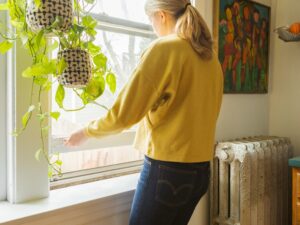Keeping warm and staying healthy: why we need a winter ventilation rethink
The UK is in the grip of freezing temperatures, with overnight lows falling well below zero. Windows are shut tight, draughts are blocked and everyone is trying to keep the heat in. It’s an understandable instinct as heating costs are high, and homes lose warmth quickly.
But, while closing everything up feels sensible, it brings a dangerous consequence: damp, condensation and black mould. As we heat our homes but reduce ventilation, indoor air becomes humid and stale. Hidden moisture settles on cold walls and windows, and, in the darkest corners, mould begins to grow.
This is already a problem in thousands of homes, but it becomes far worse during cold spells. Unlike Germany, where short, intense ventilation practices (Lüften) are part of daily life, the UK has never developed a winter-proof ventilation culture. And, as our homes become more airtight, we urgently need to understand the risks - and how to prevent them.
What is black mould and why does it appear in winter?
Black mould, often the species Stachybotrys chartarum or Cladosporium, thrives in damp, poorly ventilated environments. It appears as dark patches, usually around window frames, external walls, behind furniture, on ceilings, in the corners of rooms, and around bathrooms and kitchens.
Mould spores multiply rapidly and become airborne. In warm homes with poor airflow, spores can cling to moist surfaces and spread unnoticed until the damage is significant.
Winter is the perfect breeding season, as indoor heating increases humidity and cold walls cause condensation. As well as this, windows tend to stay tightly shut. Into the mix we add showers and cooking, as well as drying laundry indoors.
If the humidity cannot escape, mould will grow... often within 48 hours.
Why breathing in black mould is harmful
Black mould is much more than an aesthetic problem. It releases tiny spores that are easily inhaled and can cause significant health problems, particularly for children, older adults, people with asthma or respiratory conditions, and those with weakened immune systems.
Exposure can lead to:
-
persistent coughs
-
wheezing
-
nasal congestion
-
sinus infections
-
worsening asthma
-
skin irritation, and,
-
fatigue and headaches.
Long-term exposure can have severe health consequences, particularly in poorly insulated or overcrowded homes. The tragedy of Awaab Ishak - the toddler who died following prolonged exposure to mould in social housing - is a stark reminder of how dangerous it can be.
So, while a warm house is essential in winter, a ventilated warm house is safer.
Damp: the silent partner of condensation
Where there is condensation, damp usually follows. Damp comes from water vapour settling on cold walls. It can also be caused by minor leaks or plumbing issues, rising damp from poorly protected foundations, blocked gutters, or the lack of ventilation in bathrooms and kitchens.
Damp creates a perfect environment for fungi and bacteria, damages plaster and paint, and, in severe cases, can rot timber and compromise the building's fabric.
In health terms, damp is often as dangerous as mould; aggravating respiratory problems and creating cold, unhealthy indoor climates.
How to break the condensation cycle
Condensation is simple physics: warm, moist air meets a cold surface and turns to water. But, breaking that cycle requires either: reducing humidity; raising surface temperatures; improving ventilation, or, ideally, all three.
Here’s how a household can disrupt the condensation cycle.
1. Ventilate briefly and fully (Lüften)
Short, intense ventilation exchanges indoor moisture with cold, dry outdoor air without cooling the home’s structure.
In winter: 3–5 minutes is enough.
2. Use extractor fans properly
Kitchen and bathroom fans should run during and after moisture-heavy activities. Many modern fans include humidity sensors; these are especially effective in retrofitted homes.
3. Don’t dry laundry in living spaces
Where possible, dry clothes: outside, or, in a room with good extraction, or, next to a dehumidifier.
Indoor drying can release up to 2 litres of moisture per load - that's nearly half a gallon!
4. Keep furniture slightly away from external walls
Air needs to circulate. Pushing sofas or wardrobes against cold walls traps moisture and encourages mould.
5. Check for hidden cold spots
Corner rooms, north-facing walls and rooms with minimal insulation will cool fastest. Identifying these spots helps target ventilation.
6. Maintain steady heating
Allowing the home to fluctuate from extremely warm to extremely cold increases condensation. Even low background heat helps stabilise surfaces.
The Lüften approach
Lüften solves these winter problems neatly through two key methods:
1 - Stoßlüften - shock ventilation
Open all windows fully for 'a burst' of fresh air.
Winter recommendation: 3–5 minutes.
Because air exchanges quickly, the walls, floors and furniture - which hold most of a home’s heat - don’t cool dramatically.
2 - Querlüften - cross-ventilation
Open windows on opposite sides of the property simultaneously. This creates a strong airflow that replaces indoor air in under five minutes.
However... avoid Kipplüften - tilted windows
Tilting windows for long periods is discouraged. Doing so cools walls, wastes heat and increases condensation risk.
Germany has used the Lüften system for decades because it works - especially in buildings that are well insulated and airtight.
As UK homes undergo retrofit improvements, Lüften offers a practical, low-cost ventilation method during the transition.
Airtight homes and the moisture problem
Retrofit aims to make homes warmer, more energy-efficient and cheaper to heat. But, as insulation, draught-proofing and airtightness improve, moisture has fewer escape routes.
If ventilation is not upgraded at the same time, homes can become 'sealed boxes' where humidity accumulates, leading to: mould; condensation; stale indoor air; increased VOCs, and, worsened allergies.
Modern retrofits increasingly include:
-
mechanical ventilation with heat recovery (MVHR)
-
humidity-controlled fans
-
trickle vents, and,
-
ducted extraction systems.
But, until all homes reach this standard, Lüften can play a vital role in balancing airtightness with healthy airflow.
PRL's winter message: open your windows briefly, but not constantly
Many people in the UK right now are trying desperately to keep warm, and the thought of opening windows in sub-zero temperatures feels absurd. But, a few minutes of Lüften each day: reduces condensation; prevents black mould; improves indoor air quality; protects respiratory health; preserves building fabric - and... costs nothing!
It is one of the most effective ways to keep a home healthy during the coldest months - and one of the easiest habits to adopt.
Keeping the heat in doesn’t mean keeping the cold in, too
A warm, sealed home feels comforting in winter, but without ventilation it can become unsafe. As the UK experiences harsh cold spells, it is vital to remember that moisture is just as dangerous as cold.
Lüften offers a practical solution: fast, effective ventilation that prevents mould and damp without losing precious heat.
Combine it with thoughtful retrofitting, plus good heating habits, extractor fans and dehumidifiers, and we can all protect our homes and our health - even on the coldest days of the year.
Do stay safe and warm.
Carl Dodd, Property Revolutions Ltd.


